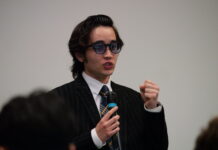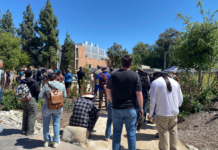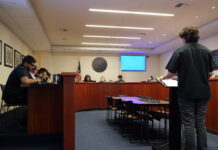
Kicking off the first ASUCR meeting of the winter quarter, senators Fernando Echeverria and Nafi Karim delivered an extensive presentation on the financial position and future of UCR’s Transportation and Parking Services (TAPS). Senators currently support the creation of overflow parking lots as the most “cost-effective intermediate solution,” which will reduce transportation expenses by converting dirt spaces into unlit parking lots with a price tag of $505,000.
TAPS plans to increase the annual cost of parking permits by 6.3 percent every year starting fall 2014-2015, which means that UCR gold permit students paying $99 per quarter will pay $105.24 the first year; $111.87 the second year and $118.91 the third year.
TAPS functions as an independent auxiliary that does not fall under the management of the university. The transportation service receives approximately 80 percent of its total revenue from UCR permit sales and citations alone, but the numbers have since fallen. According to senators, TAPS faced a drop in both permit sales and citations from the 2011-12 to 2012-13; from 4,512,477 to 4,460,562 permits and 916,661 to 549,979 citations.
“One of (TAPS’s) biggest revenue sources were citations and that went down … and that’s not necessarily a bad thing because they took a new philosophy: If you get a citation and you make an appeal, then you’re more likely to be let off the hook. You’re also given a warning before you’re given a citation,” said Echeverria.
TAPS has been tapping its reserve fund of $1,298,508 to fund an ongoing deficit under its belt, which is projected to accumulate to a $3.2 million deficit by 2018, but senators say that the reserves will eventually run dry. To find money-saving alternatives, while meeting ongoing demand for campus parking, TAPS plans to cut employee salaries and benefits by $300,000 and pursue more cost-saving, efficient projects in the future.
The presentation says the permit increases and consolidation of TAPS staffing will allow TAPS to break even by 2017-2018, with the assumption that there will be 25,000 students attending UCR by then.
Senators reported that an increase in TAPS expenditures in 2011-12 resulted in nearly a million-dollar reduction in revenue — half of the expenditure increases consisted of service center assessment fees and land rent to the university. Other expenses were the result of an increase in police surveillance over transportation equipment and maintenance. Additional costs included: the emergence of the Point-to-Point Shuttle Service and overflow parking spaces in the Grace Methodist Church parking lot adjacent Lot 26, which created 80 new spaces.
“So in easy terms, our total expenses outweighed how much we were actually making,” Echeverria said. “So at some point, we’re going to run out of money in our reserves and TAPS has to address that.”
The presentation also revealed that there are 500 student parking spaces available on a daily basis, although Karim later placed the parking estimate to be an average of around 300 spaces, which may not always be visible. Senators Echeverria and Karim are working to set up digital sign boards in each parking lot, which will show the number of available parking spots in the area. They are also working with ASUCR President Sai Patadia to synchronize an RSS feed to provide real-time updates on parking lots through a UCR application.
“The issue is that parking is really bad the first two to three weeks of school when people are still getting used to it,” said Karim. “One possible option is that we can build a parking structure to accommodate all possible students, but it would cost the student body $18,000-$25,000 per space.”
Senators revealed that building a new parking lot would cost an estimated $30 million within a 30-year period with an annual payment of $1.7 million. Since TAPS is considered an independent business, they would have to increase the price of parking permits by 50 percent in order to pay for the new structure.
TAPS is planning to provide additional parking spaces in a designated unlit dirt lot near Lot 30, which is expected to be open by spring quarter. “In total it cost $505,000 to have new lights for safety in areas like lot 26 and to set up the overflow parking lot (which will cut cost by leaving it as dirt space and having no lights, since high traffic are usually only a problem during afternoons and special events and not a regular problem at all times of the day),” said Karim.
The addition of 500 available parking spaces are expected to open up from Lot 13, when the Glen Mor 2 construction is complete in fall of 2014, according to Karim.
Highlights
Senators passed two resolutions, which supports the Union Auto Workers 2865 — consisting of UC teaching assistants, tutors and readers — during its contract negotiations with the UC and the United States Students Association’s efforts to advocate for public higher education through the 10 UC campuses.
Senators also passed partial revisions to the ASUCR bylaws, which clarify the qualifications, powers, stipend levels and terms of removal and vacancy for the executive cabinet and its staff; members of ASUCR later revealed that bylaw changes from the previous year were never updated. Additionally, bylaw changes no longer require senators to have a minimum number of office hours per quarter.
Senators Michael Ervin and Abraham Galvan seek to establish a permanent diversity council with the cultural and religious student organizations in Costo Hall.
Senator Jessica Moncayo reported that she is working to establish stronger ties between ASUCR and the UCR athletics department, such as by having senate members come out to cheer during sports games.
Senator Shadi Matar is pursuing a project to repaint UCR’s mural, which is located near Lot 1 and under the freeway on University Avenue.
ASUCR’s executive and judicial branch faced minor disagreements after a justice was not given permission to speak during a senate meeting.








